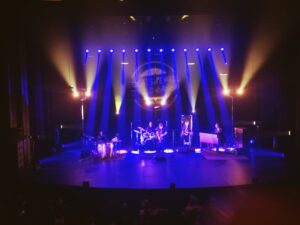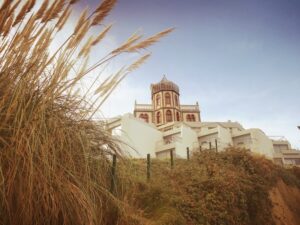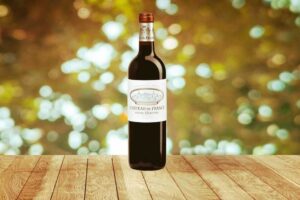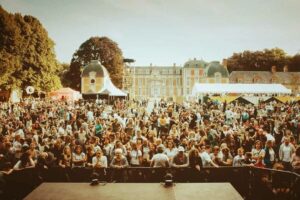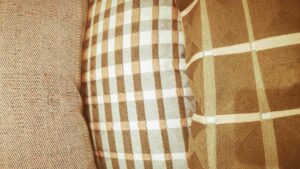Montbéliard, what else?
11 min read
Montbéliard, in the heart of the Doubs is today still largely marked by the elegant castle which stands on a rocky outcrop. Former capital of the Principality of Württemberg, it was only from 1793 that this territory was attached to the young French Republic, having remained more than 350 years in the lap of the Holy Roman Empire.

From this troubled and prestigious past, the city has kept many traces, elegant mansions, high facades, typical of the country, as well as a temple built at the beginning of the 17th century, but also a synagogue dating from the end of the 19th century, in a time when the jewish community was in full expansion.

Castle of the Dukes of Württemberg (Photo credits: Sylvie Roman).

Les Halles de Montbéliard building and the former “Bains-Douches” turned into a restaurant and showroom (Photo credits: Sylvie Roman)
An omnipresent industrial past
The industrial past is also found in various places, like this gigantic lion on a facade of the city, witness of the time when the firm Peugeot, was very powerful.
It is indeed in 1912 that the site of Sochaux is created, straddling the two towns of Montbéliard and Sochaux. It thus becomes the biggest production site of the Lion brand.
The shimmering world of Henry Valensi is exposed at the Dukes
The castle of the Dukes of Württemberg, sitting on a rocky promontory, has undergone many transformations throughout the ages, sporting a Renaissance exterior for an interior acquired to the modernity of a museum, for this exceptional site located 10km from the Swiss border and changed from its original function in the 19th century.
transformations throughout the ages, sporting a Renaissance exterior for an interior acquired to the modernity of a museum, for this exceptional site located 10km from the Swiss border and changed from its original function in the 19th century.
 Today, it is one part of the two municipal museums belonging to the municipality of Montbéliard.
Today, it is one part of the two municipal museums belonging to the municipality of Montbéliard.
This exceptional place highlights the undervalued work of the very international painter Henry Valensi of Algiers, since he was the only French artist to participate in the “Jack of Diamonds Show” in Moscow.
An exhibition in four sessions, the first since 1963, presently part of his collection unfortunately partially spoiled by the Nazis in his Paris studio in 1940, episode that led him to take refuge in Algeria during the conflict.
A destiny that did not spare this artist, very early immobilized by various diseases and who will be brought, by the force of things, to paint, already very young, the steamers arriving in the bay of Algiers. Another event of his young life, following the Dreyfus affair and an upsurge of anti-Semitism, his family is forced to settle in Paris and an opportunity is offered to him at the School of Fine Arts.

A personality rocked by exoticism that leads him to perform a series of trips where he performs representations in the form of a radiant impressionism with a light that he deems essential for his painting that will reflect its colors, and this with a touch of Orientalism, among this current he will participate in the Orientalists Salon in 1905.

A testimony of the frescoes of his early years: Athens in 1909 and Algiers in 1912 (Photo credits: Alex Plato)
He wants to introduce a 4th dimension in his painting through the musicalism and a certain expressionism to integrate an idea of movement.
 With his painting of the Sainte Sophie church appear the first waves inspired by the emergence of his “Law” known as “Predominance “expressing a lightening of the material and intellectualization of Art, making him a theoretical artist.
With his painting of the Sainte Sophie church appear the first waves inspired by the emergence of his “Law” known as “Predominance “expressing a lightening of the material and intellectualization of Art, making him a theoretical artist.


An educational panel of the “Law of Predominances” and Musicalism (Photo credits: Alex Plato)


This expression of waves and musicality, through this representativeness of his theories, shows themes in very conceptual forms; like “Through the Sahara” of 1925 or this “Journey by Rail” in 1927 (Photo credits: Alex Plato).
 Inspired by the historical episode of Dardanelle, he will then seek to retranscribe the internalization of machines of all kinds: locomotives and such that “flying seaplane” in 1918 or this “Expression of the Dardanelles” in 1917.
Inspired by the historical episode of Dardanelle, he will then seek to retranscribe the internalization of machines of all kinds: locomotives and such that “flying seaplane” in 1918 or this “Expression of the Dardanelles” in 1917.
An omnipresence of the red that symbolizes the red, flagship color of this era enunciator of currents such as Fauvism, like the representation of a “Palms Wedding at Bou Sâada” or a desire to narration, expressed with flamboyant musical notes offering a sound perception on some paintings including the “Bull Run” in 1926.

The artist will show his attachment to the arrival of cinema in colors, via yet another very personal theory of his concept of “cinema-painting” which will be expressed around an abstract film in colors imbued with this current: “The Symphony Spring “, drawn from 64,000 drawings from a painting realized in 1932, which will only end in 1959, officially entering into the collections of the National Museum of Modern Art in 2013.
 Always inspired by the movement, he goes to the sports fields to soak up the atmosphere that reigns there, with this view of the sky from “Tennis, the game” in 1930, with colors symbolizing freedom, tinged with the end of the War with this “Symphony in pink” in 1946. First light-colored fruits that could also be observed in the Great North with this “Norwegian Symphony” in 1955. (Photo credits: Alex Plato).
Always inspired by the movement, he goes to the sports fields to soak up the atmosphere that reigns there, with this view of the sky from “Tennis, the game” in 1930, with colors symbolizing freedom, tinged with the end of the War with this “Symphony in pink” in 1946. First light-colored fruits that could also be observed in the Great North with this “Norwegian Symphony” in 1955. (Photo credits: Alex Plato).

The family association managing the painter’s heritage is active to make recognize his Art, considered too confidential, including searching for paintings stolen in 1940 from his Paris studio via the Commission for Artistic Recovery (CRA).
Various hangings are planned at the Pompidou Center (thanks to the leg of 18 paintings) at the Action Center in Dunkirk.
Jules-Emile Zingg, a painter in Montbéliard
Another exhibition inside the walls of the castle is the other child of the country, Jules-Emile Zingg, born in 1882, is admitted to the Beaux Arts in Paris, and began an interesting career, influenced by the Nabis he rubs shoulders by the paintings of Paul Gauguin. Quickly, in 1918, he enjoyed a personal exhibition at the Druet Gallery, which gained him a national recognition. The Museum of Württemberg Castle presents many works of regionalism, with country scenes, peasant scenes and landscapes of his native Franche-Comté. But we recognize the dough of a talented painter, who has the job, and above all, dares the flats of matter, the pure colors, the agreements in the lineage of these different currents that confront and sometimes clash in these years 1920 and 1930.

Zingg in all its features (Photo credits: Sylvie Roman)

The Museums of Montbéliard
The city is the cradle of an illustrious figure, Georges Cuvier, the famous paleontologist, who later taught and made a career in Paris. His research and his work are traced in several rooms of the Castle Museum: fossils of vertebrates, plants (some very old and rare), retrace the geological periods of the region. Finally, thanks to several scientists from the region, the museum also presents several zoological and botanical collections, constituting a background of several thousand references. A reserve of a significant number of nearly 525,000 pieces including 200,000 archaeological pieces.
The Beurnier-Rossel Museum, a dive into the 18th century
The Museum of Art and History takes place in an elegant mansion built in 1774, close to the Reformed Temple. The first rooms simply retrace the opulent interior of this frank-county family. Inlaid furniture, painted decorations, especially an impressive fireplace covered with blue and yellow tiles. Above all, we discover a whole collection of music boxes and clocks, reflecting a local know-how, which has long made the reputation of the region.



A colorful part of the local History! (Photo credits: Sylvie Roman)
Finally, evidence of a region that was at the forefront of innovation, many buildings built of raw concrete, still graze the country of Montbéliard today: such those 1950s “Bains-Douches”, and cleverly converted into a restaurant and dining room. Otherwise, the Church of the Immaculate Conception in Audincourt, one of the first religious buildings built in reinforced concrete, in 1932, and still admired by the quality, the lines and the marvelous modern stained glass windows (Valentine Reyre and François-Claude Laurent). Second all concreted building , the Sacred Heart Church, still in Audincourt, built in the late 40s, on plans by Maurice Novarina, and stained glass designed by Fernand Léger.
So, not to mention gastronomy, with the famous cheeses and the yellow wine, or by nature, the discoverers will have something to do too, with the culture.
Interview with Didier Val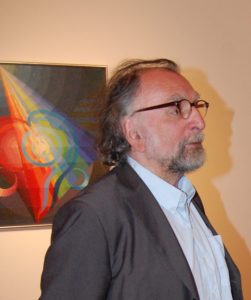 lens, heir of Henry Valensi, “the goldsmith of color” by Fouzia Marouf
lens, heir of Henry Valensi, “the goldsmith of color” by Fouzia Marouf
While Montbéliard celebrates the Christmas lights from November 25 to December 24, exclusively dedicated to collections from the early 20th century, the museum of the castle of the Dukes of Württemberg devoted this summer a retrospective upon the impressive Artwork of Henry Valensi (1883-1960) through the exhibition “The music of colors”. Eternal traveler, intrepid Algiers kid, painter of the modernity in the yard of Orphism and futurism, this leader of the Musicalist movement, depicts in music the colors on the canvas and names symphony, prelude or fugue his works like the most powerful ones. This second retrospective since 1963 presents the history of this prolific artist, alternately, illustrator, enlightened thinker, since the hanging pluralities of the Center Pompidou in 2013. An informed interview with Didier Vallens, entitled to return on the steps of this singular artist and his living paintings as unknown as intriguing.
What is the genesis of the Henry Valensi exhibition “the music of colors” at the Castle Museum of the Dukes of Württemberg in Montbéliard?
Since a press conference in June 2014, I had kept in touch with Caroline Hancock, art historian and curator, who helped us a lot. It turns out that she had mounted an exhibition in Montbéliard on Scotland, her homeland, and then put me in touch with Aurélie Voltz, director of this museum, and we quickly started this exhibition spring-summer 2017, with great mutual satisfaction.
How did you welcome the idea of this event dedicated to the prolific work of your uncle, the painter Henry Valensi?
With hindsight, both as a natural continuation of the various actions that I had led, as the end of a stage, and as the confirmation of a new recognition, overflowing the circles of Paris.
You have confided to being fascinated by his whimsical nature and overflowing creativity …
Born in 1948, I knew Henry well, whom I often visited in his studio, located in the same building as my parents, and that I admired him painting on the one hand, and making his film in another. It was a real opening to a world I didn’t know.
Which emblematic works have you marked and why?
The “Railway Journey”, the “Bull Run”, “Niewpoort”. I didn’t see them born, under the hand and eye of the artist, like others later, but these three were hooked on my parents during my childhood.
Tell us about the association of the rights holders of this unclassifiable artist …
We are officially 5 rightful owners: myself, my brother Jean-Luc, and my cousins: Anne, on one side, and Philippe and Gerard on the other, the latter three being the grandchildren of the 3rd of the siblings, Marguerite, sister of Henry, all about the same age, today between 69 and 73 years old.
I don’t feel “custodian” of his work, this term does not really make sense to me in this case. Things have been done gradually and naturally: first, we have been surrounded by Henry Valensi since our youth, paintings, memories, meetings, etc. It is therefore, for me at least, part of my existence from the beginning.
It was my father, who lived on the spot during the Occupation, had tried to save what he could from the workshop and from Henry’s home during their looting by the Germans in 1941, at his own risk (Henry had fled to Algiers, his hometown).
At the death of my father (1983) who had kept many Henry’s documents in the same building, I took charge myself, and I started with the nascent microcomputer, to draw up an inventory. It included the list of 1,200 works (studies and paintings) that Henry had made and which I had at the time found traces of their existence (since then, many others have added).
And I’m at the 3rd association:
In 1990, we created the AAPHV: Association of the Friends of the Painter Henry Valensi, Leader of the Musicalist Artists. It brought together members of my family, at the time a little more numerous than today, friends, Galerie Drouart and a few others
In 2011, we create the AADPHV: Association of the Right-holders of the Painter Henry Valensi, by nature limited in number of members, but to which some other people have associated
In 2015, we create the AHV: Association Henry Valensi, taking up the spirit of the first association, open, to which we immediately decided to associate a Scientific Committee (or Valensi Committee), which will have a vocation of consulting and will remain consultative. We are now ten members and remain open.
Born in Algiers, Henry Valensi was successively a privileged witness of the traditional, popular cultures of the Mediterranean basin. His paintings of a rare force depicting slices of life of the natives and sets under the light of Fez, Marrakech, Algiers, Tunis, Sahara, Cordoba, Toledo, Rome, Athens, Constantinople, Monaco…
Among his claimed values, one will indeed quote in fact Mondialism and Universalism cultural: the sketches and the paintings of voyage of Henry Valensi across Europe and the Maghreb express a vision of the art respecting all the styles and all the periods ( marked interest in Muslim art, bringing together painting from East and West). He has also deeply studied the history of all the arts in all eras and countries (see his theory of Predominances).
Can we hope to see his art flourish in galleries and museums from the south shore?
His paintings are starting to disperse, but it’s only up to the enlightened amateurs, as some museums and galleries around the world are, to propose such events.
What do you remember from his prolix art and his person, the spearhead of musicalism, the precursor of cinematography?
It is today a bit forgotten, but it remains strategic, for sure: we had in 1990 and the following years, with other rights holders, wrote a small note about the visionary artist he was: multi-cultural (as painter of Euro-Mediterranean, see above), multi-media: drawings, paintings, many scientific-based articles on wavelengths, such as emotional affective resonance, written in 1955, today known as chromo-psychology, history: we are in possession of an important manuscript / typescript of more than 1000 pages entitled History of all the Arts, in all places and at all times (still being transcribed, and never published or edited). And then, of course, cinema, under the name he created of Cinépeinture, with in addition a vision of interactive television quasi-prophetic (in 1960, see box below)
And there, we approach the Telepainting, so named for this double reason:
a) By the creation of our desired device, we will obtain electrically all the desired colors in a projected form (and no longer pigmented) hence lightening “and especially beauty of the color
b) we will send its moving colors on the screen of the device without contact with this screen: we will paint from afar! We will distribute “afar” (urbi and orbi) the work realized then recorded and broadcast by the cinema. We will be doubly “telepeintre” since the four corners of the universe the work can be seen on the same days and hours from its publication.
and what we know today as a graphic palette or even a touch screen:
Let us add, however, that it is entitled to consider the camera as the first possible material in the immediate future, but that this material will evolve towards a creation (perhaps electronic?) Able to allow him to improvise on a screen (or in space?) moving color shapes. And thus creating a music of colors, like 100 different and tuned instruments, allow the composer to create a music of sounds.
Extract from the Proceedings of the 4th Congress of Aesthetics, Athens, 1960
Extract from “Palette and Camera” Revue d’Esthétique, 1951 (!)
Report produced in close collaboration with Sylvie Roman and Fouzia Marouf.



